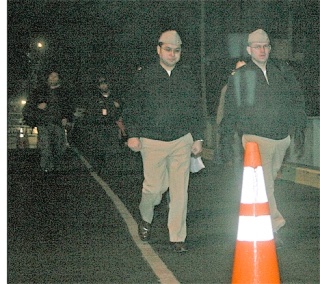With limited ferry service at Keystone Harbor, commuters crossing Admiralty Inlet have had to find a variety of solutions to deal with ever-changing conditions.
For a number of personnel at Whidbey Island Naval Air Station, military and civilian alike, they have to rely on vanpools, finding temporary places to stay, or making a much longer drive to and from work each day.
The ferry service is so important to Navy personnel in the Puget Sound region that the Northwest Region commander recently sent a letter to the Washington State Ferries director, urging the state to maintain ferry service.
The Keystone to Port Townsend ferry route, which provides the fastest way to the Olympic Peninsula, has been in turmoil since late 2007 when the antiquated Steel Electrics were retired for safety reasons. Since then, a combination of a leased car ferry and a variety of passenger-only ferries have served the route.
Car ferry service was on hold for weeks until Steilacoom II returned to service Feb. 12. The rented ferry was in drydock undergoing maintenance. The Mystic Sea offered passenger ferry service in the larger boat’s absense.
The vessel switch forced many commuters to change their ways.
Chief Petty Officer Tracy Brehmer, who helps coordinate van pools at the base, said he had to work with transit systems on both sides of Admiralty Inlet. Participants need vans on either side of the ferry route to make sure transportation is available. There are 45 people who commute to the base from the peninsula each day.
He complimented the work of ferry officials who helped coordinate transportation for commuters. However, the vanpools work smoothly only when there’s a group of people with similar schedules. For those who have a non-traditional work schedule, the foot ferry becomes impractical.
“It’s too hard to do the passenger-only ferry,” said Command Master Chief Tracye Sherrill. She said to commute between the Navy base and her home in Belfair, she would need a car on either side of the ferry route to make it work.
She stressed that she does the commute by choice. She didn’t want to sell her home when she was transferred to NAS Whidbey years ago. Instead, she lives in a motorhome on Whidbey Island during the week and drives to Belfair on weekends.
Sherrill said the biggest improvement to the ferry run was the implementation of a reservation system. Having a guaranteed spot on the Steilacoom II cuts down on waiting times and commuting times.
Commuters are all dealing with the reduced reliability of ferry service on the route due not only to juggling boats, but weather conditions.
“I think the biggest impact has been predictability,” said Jesse James, a team training manager who work at the Naval Ocean Processing Facility at the base. He said the rough weather common on Admiralty Inlet often forces delays on the route.
Mystic Sea had to cancel runs due to high winds, heavy seas and thick fog.
When that happens, James finds himself driving to Edmonds to take a ferry to Kingston. It takes him five hours to get home when he has to drive around. It’s also expensive. The diesel fuel and ferry fares run him about $60 daily.
James said that any delays caused by the boats or problems at work extend his day and disrupt any reservations he may have made to get a guaranteed spot on the boat.
“The bottom line is they need to restore the amount of service they had before,” James said. That service included having two boats on the route during the spring summer. He said that the single-boat summer commute is “insane” and negatively affects commerce.
“We’re hoping that Washington State Ferries concedes the point that this is a state highway,” James said, recommending that the state spend the necessary money to restore the service on the route that had been in place for decades.
However, that may be unlikely at this point. Washington State Ferries has submitted two future operating scenarios to the 2009 Legislature, and neither includes a second ferry at Keystone.
Local leaders are working to make a second boat happen, but as for now commuters on the Keystone to Port Townsend run have to accommodate themselves to the frequent changes in service. You never know for sure if you’ll get across Admiralty Inlet on time.



